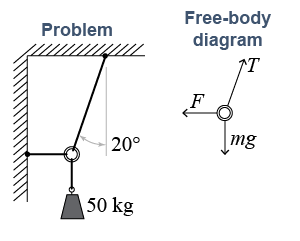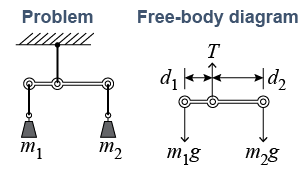|
Static equilibrium means that both the net force is zero in all directions and the net torque is zero around any center. Torque is the “twisting” equivalent of force. Torque is force times distance, which has SI units of newton-meters and has units of pound-feet in the English system. The torque created by a force is the magnitude of the force multiplied by the lever arm, which is the perpendicular distance from the center to the line of action of the force. The general procedure for solving static problems is to create a free-body diagram, resolve all forces into components, and then apply the equilibrium conditions for both forces and torques. 
|
|
torque, line of action, lever arm, fulcrum, lever
|
|
|
|
Review problems and questions |
|

- Which of the following gives the correct force equilibrium equations for the problem on the right?
- Tx − F = 0, Ty − mg = 0
- Ty − F = 0, Tx − mg = 0
- T − F − mg = 0
- T + F + mg = 0


|
Choice a is correct. Since the ring at the center of the system is in equilibrium, the vector sum of all of the forces acting upon it is zero. That means we can apply the formula Σ = 0. In this case, the forces all act in one plane so the vector has only x- and y-coordinates. The horizontal or x-component of the tension T opposes the horizontal force F applied by the rope to the left of the ring. Therefore Tx − F = 0. Meanwhile, the vertical or y-component of the tension counters the weight of the 50 kg mass that hangs from the ring. In mathematical terms, Ty − mg = 0. 
|

- What is the torque created by the force drawn in the diagram?
- 25 N m
- −25 N m
- 100 N m
- −100 N m


|
Choice a is correct. The torque depicted in this problem is approximately 25 N m. The applied force is perpendicular to the distance between the hand and the center of rotation. This means that we can simply multiply the force by the distance. That tells us that the magnitude of the torque is 25 N m. However, the torque could be positive or negative. Counterclockwise torques, by convention, are considered positive, and the torque shown here is counterclockwise. Hence, choice a is correct here. 
|

- Which of the following equations is a correct statement of rotational equilibrium for the problem on the right?
- m1g + m2g + T = 0
- m1gd1 + m2gd2 = 0
- m1gd1 − m2gd2 = 0
- m1gd1 + m2gd2 + T = 0


|
Choice c is correct. The center of rotation is the pivot point hanging from the ceiling by a rope. The tension in that rope provides zero torque because it pulls directly from the pivot point—neither clockwise nor counterclockwise. By contrast, the weights of the two masses do apply torques to the pivot point. Mass 1 applies a force that operates in a counterclockwise direction, so its torque (m1gd1) is positive, whereas the torque applied by Mass 2 (m2gd2) is clockwise (and therefore gets a minus sign). The sum of these these two components is zero, so the final expression is m1gd1 − m2gd2 = 0. 
|
Take a Quiz |

